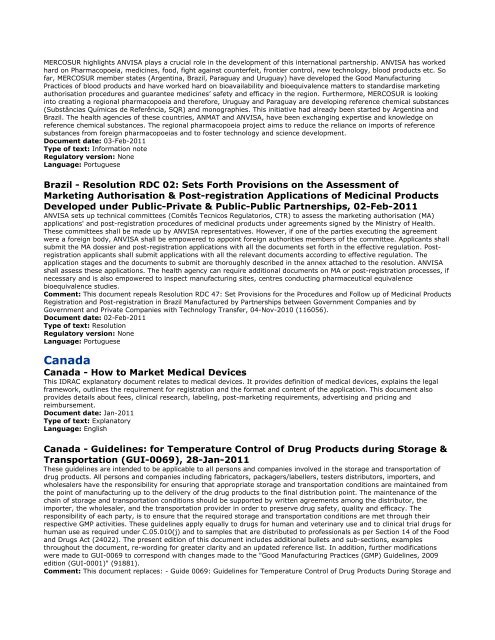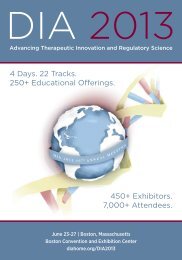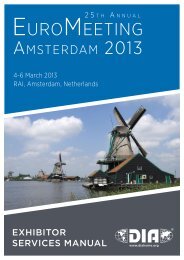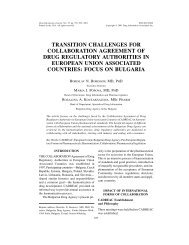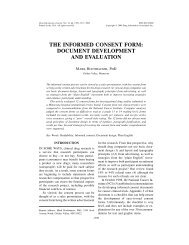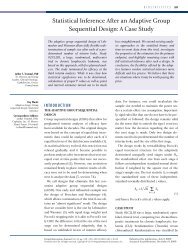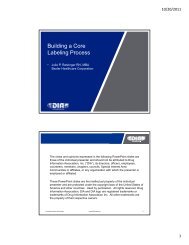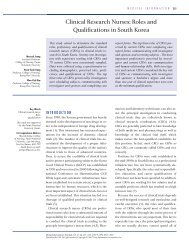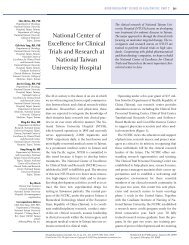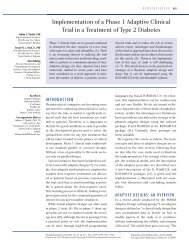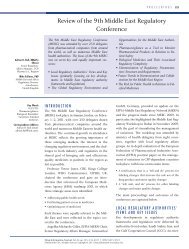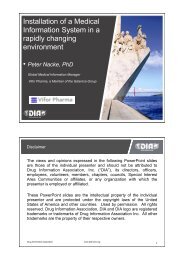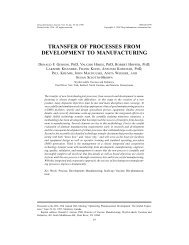Argentina - Drug Information Association
Argentina - Drug Information Association
Argentina - Drug Information Association
You also want an ePaper? Increase the reach of your titles
YUMPU automatically turns print PDFs into web optimized ePapers that Google loves.
MERCOSUR highlights ANVISA plays a crucial role in the development of this international partnership. ANVISA has worked<br />
hard on Pharmacopoeia, medicines, food, fight against counterfeit, frontier control, new technology, blood products etc. So<br />
far, MERCOSUR member states (<strong>Argentina</strong>, Brazil, Paraguay and Uruguay) have developed the Good Manufacturing<br />
Practices of blood products and have worked hard on bioavailability and bioequivalence matters to standardise marketing<br />
authorisation procedures and guarantee medicines’ safety and efficacy in the region. Furthermore, MERCOSUR is looking<br />
into creating a regional pharmacopoeia and therefore, Uruguay and Paraguay are developing reference chemical substances<br />
(Substâncias Químicas de Referência, SQR) and monographies. This initiative had already been started by <strong>Argentina</strong> and<br />
Brazil. The health agencies of these countries, ANMAT and ANVISA, have been exchanging expertise and knowledge on<br />
reference chemical substances. The regional pharmacopoeia project aims to reduce the reliance on imports of reference<br />
substances from foreign pharmacopoeias and to foster technology and science development.<br />
Document date: 03-Feb-2011<br />
Type of text: <strong>Information</strong> note<br />
Regulatory version: None<br />
Language: Portuguese<br />
Brazil - Resolution RDC 02: Sets Forth Provisions on the Assessment of<br />
Marketing Authorisation & Post-registration Applications of Medicinal Products<br />
Developed under Public-Private & Public-Public Partnerships, 02-Feb-2011<br />
ANVISA sets up technical committees (Comitês Tecnicos Regulatorios, CTR) to assess the marketing authorisation (MA)<br />
applications' and post-registration procedures of medicinal products under agreements signed by the Ministry of Health.<br />
These committees shall be made up by ANVISA representatives. However, if one of the parties executing the agreement<br />
were a foreign body, ANVISA shall be empowered to appoint foreign authorities members of the committee. Applicants shall<br />
submit the MA dossier and post-registration applications with all the documents set forth in the effective regulation. Postregistration<br />
applicants shall submit applications with all the relevant documents according to effective regulation. The<br />
application stages and the documents to submit are thoroughly described in the annex attached to the resolution. ANVISA<br />
shall assess these applications. The health agency can require additional documents on MA or post-registration processes, if<br />
necessary and is also empowered to inspect manufacturing sites, centres conducting pharmaceutical equivalence<br />
bioequivalence studies.<br />
Comment: This document repeals Resolution RDC 47: Set Provisions for the Procedures and Follow up of Medicinal Products<br />
Registration and Post-registration in Brazil Manufactured by Partnerships between Government Companies and by<br />
Government and Private Companies with Technology Transfer, 04-Nov-2010 (116056).<br />
Document date: 02-Feb-2011<br />
Type of text: Resolution<br />
Regulatory version: None<br />
Language: Portuguese<br />
Canada<br />
Canada - How to Market Medical Devices<br />
This IDRAC explanatory document relates to medical devices. It provides definition of medical devices, explains the legal<br />
framework, outlines the requirement for registration and the format and content of the application. This document also<br />
provides details about fees, clinical research, labeling, post-marketing requirements, advertising and pricing and<br />
reimbursement.<br />
Document date: Jan-2011<br />
Type of text: Explanatory<br />
Language: English<br />
Canada - Guidelines: for Temperature Control of <strong>Drug</strong> Products during Storage &<br />
Transportation (GUI-0069), 28-Jan-2011<br />
These guidelines are intended to be applicable to all persons and companies involved in the storage and transportation of<br />
drug products. All persons and companies including fabricators, packagers/labellers, testers distributors, importers, and<br />
wholesalers have the responsibility for ensuring that appropriate storage and transportation conditions are maintained from<br />
the point of manufacturing up to the delivery of the drug products to the final distribution point. The maintenance of the<br />
chain of storage and transportation conditions should be supported by written agreements among the distributor, the<br />
importer, the wholesaler, and the transportation provider in order to preserve drug safety, quality and efficacy. The<br />
responsibility of each party, is to ensure that the required storage and transportation conditions are met through their<br />
respective GMP activities. These guidelines apply equally to drugs for human and veterinary use and to clinical trial drugs for<br />
human use as required under C.05.010(j) and to samples that are distributed to professionals as per Section 14 of the Food<br />
and <strong>Drug</strong>s Act (24022). The present edition of this document includes additional bullets and sub-sections, examples<br />
throughout the document, re-wording for greater clarity and an updated reference list. In addition, further modifications<br />
were made to GUI-0069 to correspond with changes made to the "Good Manufacturing Practices (GMP) Guidelines, 2009<br />
edition (GUI-0001)" (91881).<br />
Comment: This document replaces: - Guide 0069: Guidelines for Temperature Control of <strong>Drug</strong> Products During Storage and


